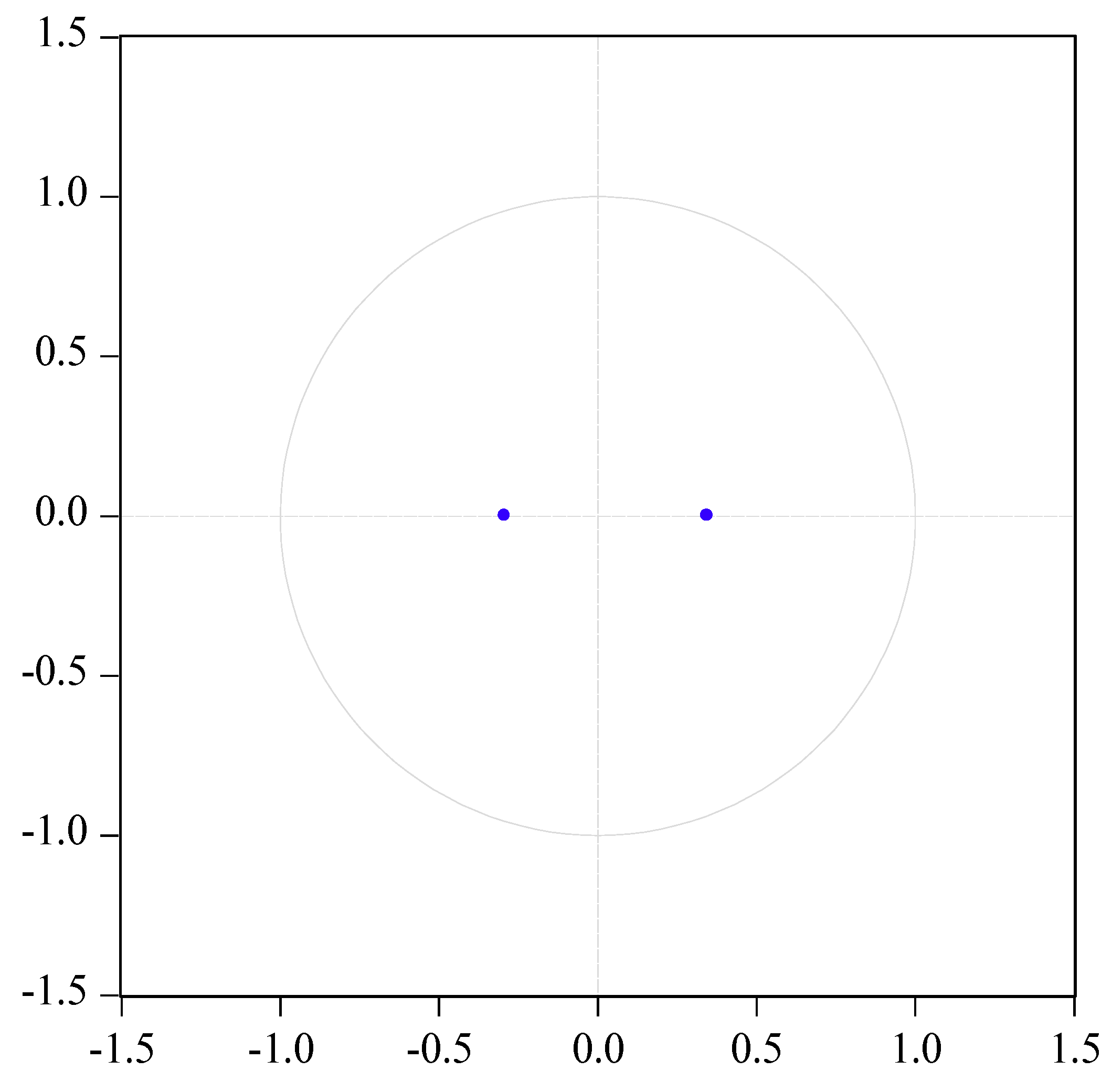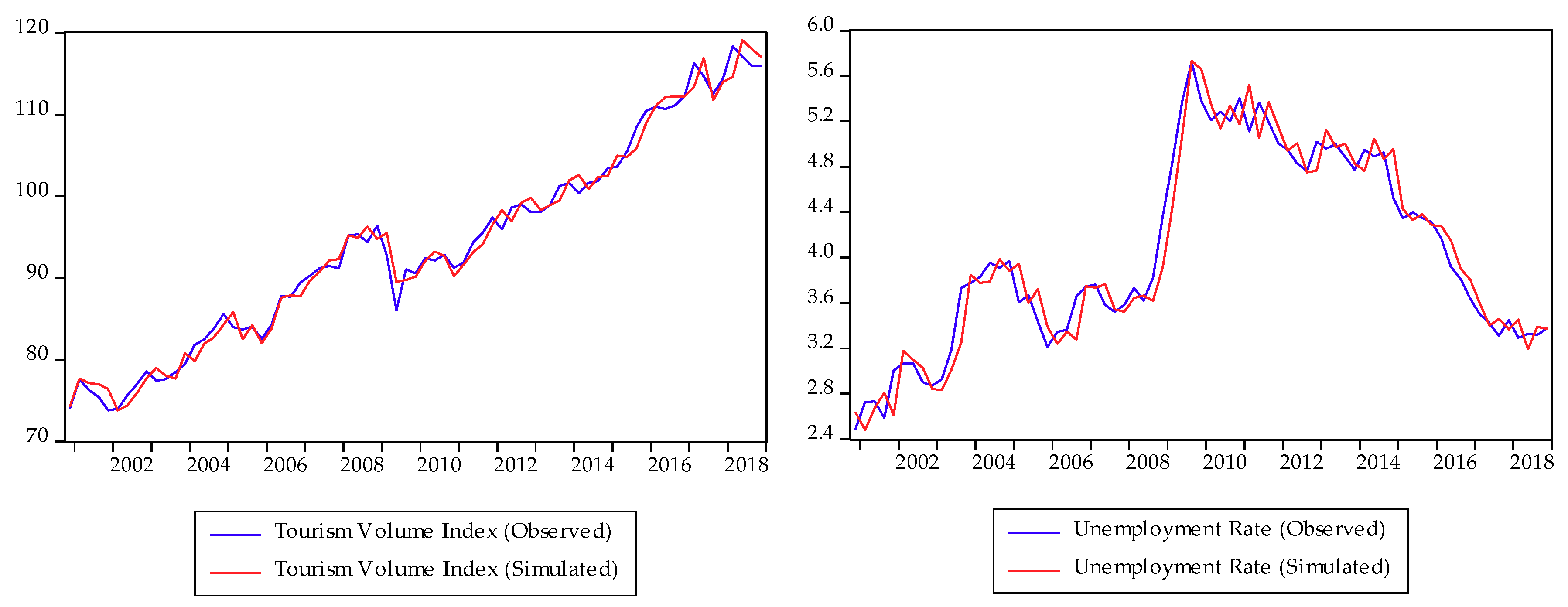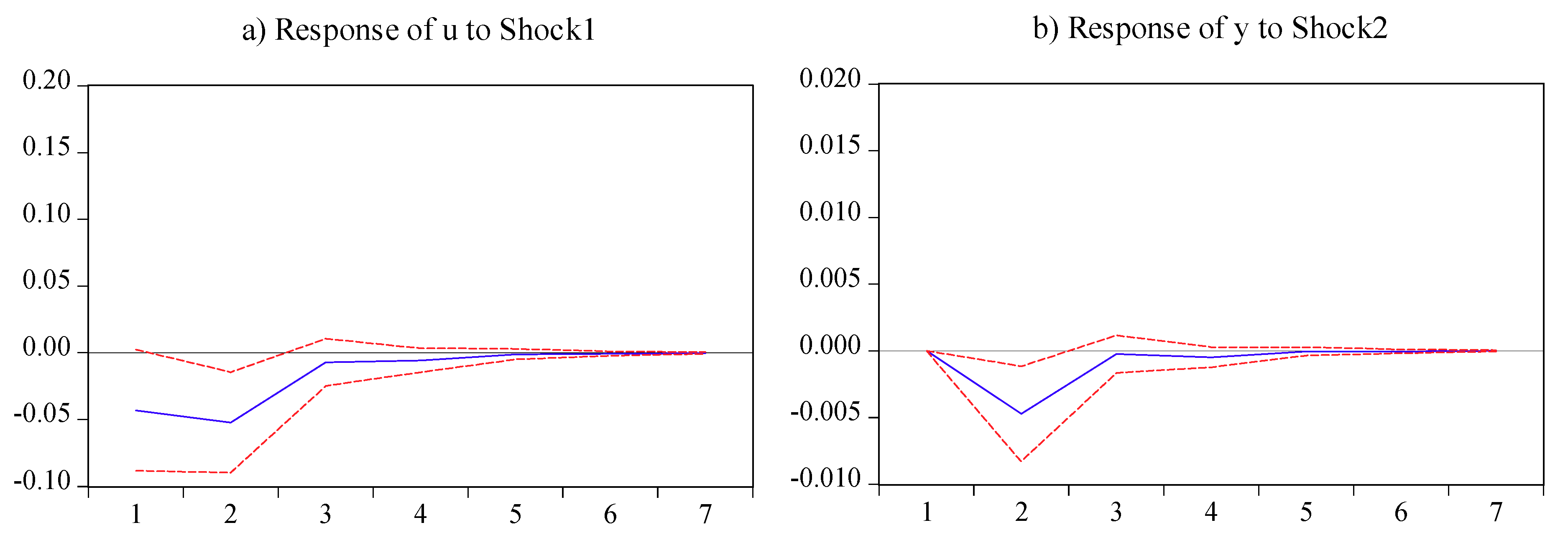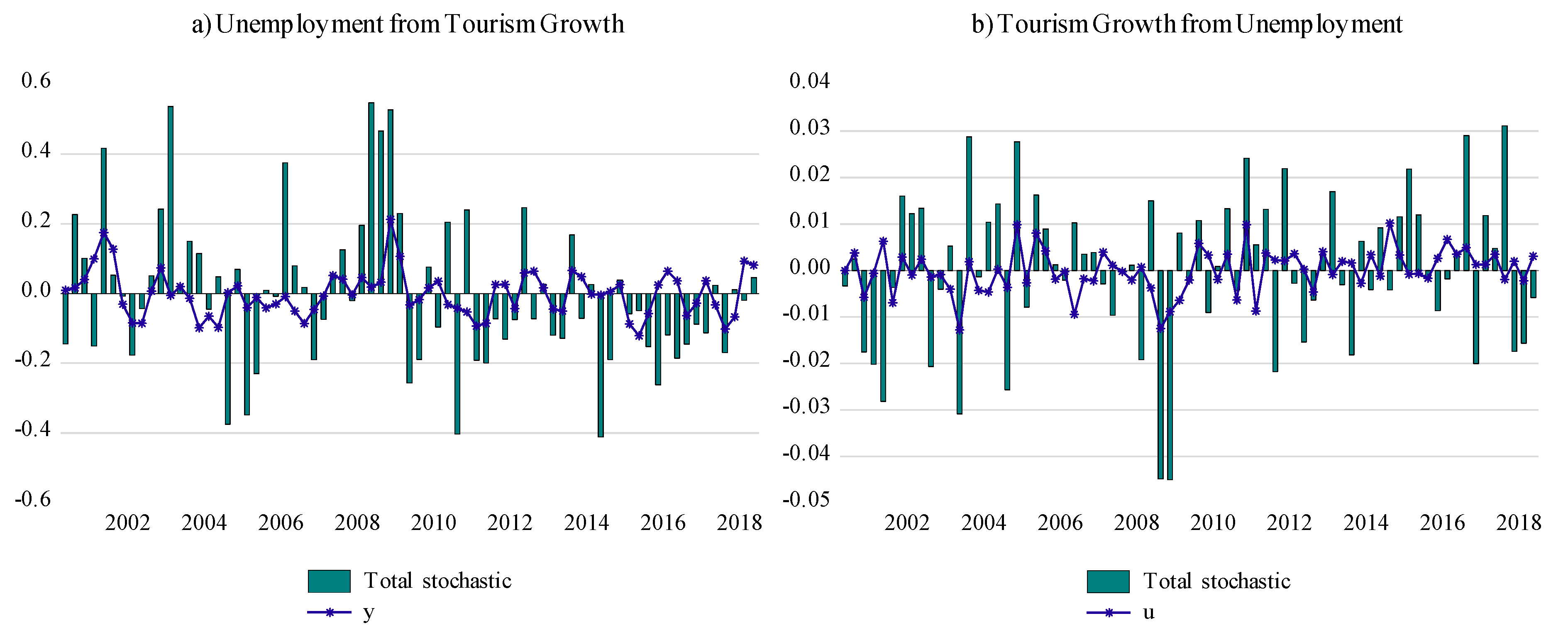Unemployment and Growth in the Tourism Sector in Mexico: Revisiting the Growth-Rate Version of Okun’s Law
Abstract
1. Introduction
2. Okun’s First Differences Model and Okun’s Law
3. Tourism and Employment
4. Data and Sources
5. Empirical Design
6. Empirical Results and Discussion
7. Conclusions
8. Limitations
Funding
Conflicts of Interest
Appendix A

| Unemployment Equation | ||||
| Test | Without | With | ||
| Statistic | Probability | Statistic | Probability | |
| Maximum LR F-statistic (2009Q4) | 5.1318 | 0.0270 | 3.8829 | 0.0644 |
| Maximum Wald F-statistic (2009Q4) | 15.3956 | 0.0270 | 15.531 | 0.0644 |
| Exp LR F-statistic | 0.9469 | 0.1838 | 0.7039 | 0.3524 |
| Exp Wald F-statistic | 4.6032 | 0.0374 | 4.6588 | 0.0774 |
| Ave LR F-statistic | 1.3790 | 0.1965 | 1.1711 | 0.2882 |
| Ave Wald F-statistic | 4.1372 | 0.1965 | 4.6847 | 0.2882 |
| Tourism Output Growth Equation | ||||
| Test | Without | With | ||
| Statistic | Probability | Statistic | Probability | |
| Maximum LR F-statistic (2009Q3) | 3.0332 | 0.2853 | 2.0434 | 0.5836 |
| Maximum Wald F-statistic (2009Q3) | 9.0996 | 0.2853 | 8.1736 | 0.5836 |
| Exp LR F-statistic | 0.2762 | 0.8931 | 0.4934 | 0.6224 |
| Exp Wald F-statistic | 1.3488 | 0.6491 | 2.2377 | 0.5276 |
| Ave LR F-statistic | 0.4885 | 0.8694 | 0.9465 | 0.4607 |
| Ave Wald F-statistic | 1.4657 | 0.8694 | 3.7861 | 0.4607 |
| Variable | VIF |
|---|---|
| NA | |
| 1.087383 | |
| 1.020497 | |
| 1.071513 |
References
- Acerenza, Miguel Ángel. 2012. Efectos Económicos, Socioculturales y Ambientales del Turismo. Mexico: Trillas. [Google Scholar]
- Alarcón, Moisés Alejandro, and Irvin Mikhail Soto. 2017. Heterogeneidad estructural en la estimación de la Ley de Okun para el caso mexicano. Realidad, Datos y Especio. Revista Internacional de Estadística y Geografía 8: 73–92. [Google Scholar]
- Alegre, Joaquín, Llorenç Pou, and Maria Sard. 2018. High unemployment and tourism participation. Current Issues in Tourism, 1–12. [Google Scholar] [CrossRef]
- Álvarez, Pablo. 1996. La relación de los servicios y el turismo con el sector externo en México. Comercio Exterior 46: 148–57. [Google Scholar]
- Álvarez-Díaz, Marcos, Manuel González-Gómez, María Soledad Otero-Giráldez, and Ana Belén Trigo. 2014. Modelización Econométrica de la Demanda de Turistas Británicos a España. Working Paper, 14/04. Vigo: Universidad de Vigo. [Google Scholar]
- Andrés-Rosales, Roldán, Luis Alberto Sánchez-Mitre, and José Nabor Cruz. 2018. Insecurity and its impact on tourism in Guerrero: A spatial approach, 1999–2014. Revista de Relaciones Internacionales, Estrategia y Seguridad 13: 147–62. [Google Scholar] [CrossRef]
- Ascanio, Alfredo. 2012. Teoría del Turismo. Mexico: Trillas. [Google Scholar]
- Balaguer, Jacint, and Manuel Cantavella-Jordá. 2002. Tourism as a long-run economic factor: The case of Spain. Applied Economics 34: 877–84. [Google Scholar] [CrossRef]
- Ball, Laurence, Daniel Leigh, and Prakash Loungani. 2012. Okun’s Law: Fit at 50? Paper presented at 13th Jacques Polak Annual Research Conference. International Monetary Fund. Available online: https://www.imf.org/external/np/res/seminars/2012/arc/pdf/BLL.pdf (accessed on 5 September 2018).
- Ballabriga, Fernando C., Luis Julián Álvarez, and Javier Jareño. 1998. Un Modelo Macroeconómico BVAR para la Economía Española: Metodología y Resultados. Estudios Económicos No. 64. Madrid: Banco de España. [Google Scholar]
- Banskota, Kamal. 2012. Impact of tourism on local employment and incomes in three selected destinations: Case studies of Sauraha, Nagarkot and Bhaktapur. Nepal Tourism and Development Review 2: 1–31. [Google Scholar] [CrossRef]
- Barreto, Humberto, and Frank Howland. 1993. There Are Two Okun’s Law Relationships between Output and Unemployment. Available online: https://www.researchgate.net/publication/228421484_There_Are_Two_Okun%27s_Law_Relationships_between_Output_and_Unemployment (accessed on 8 April 2019).
- Bote, Venancio. 1990. Planificación Económica del Turismo: De una Estrategia Masiva a una Artesanal. Mexico: Trillas. [Google Scholar]
- Brida, Juan Gabriel, Edgar J. Sánchez, and W. Adrian Risso. 2008. Tourism’s impact on long-run Mexican economic growth. Economics Bulletin 3: 1–8. [Google Scholar]
- Caballero, Pilar. 2011. Estacionalidad turística y temporalidad del empleo ¿Reservas de Eficiencia? Cuba: Investigación Económica 17: 26–56. [Google Scholar]
- Cárdenas, Fabio. 1990. Comercialización del Turismo: Determinación y Análisis de Mercados. Mexico: Trillas. [Google Scholar]
- Charemza, Wojciech W., and Derek F. Deadman. 1997. New Directions in Econometric Practice: General to Specific Modelling, Cointegration and Vector Autoregresion. Cheltenham: Edward Elgar Publishing. [Google Scholar]
- Chou, Ming Che. 2013. Does tourism development promote economic growth in transition countries? A panel data analysis. Economic Modelling 33: 226–32. [Google Scholar] [CrossRef]
- Dahdá, Jorge. 1998. Publicidad Turística. Mexico: Trillas. [Google Scholar]
- Dahdá, Jorge. 2003. Elementos de Turismo: Economía, Comunicación, Alimentos y Bebidas, Líneas Áreas, Hotelería, Relaciones Públicas. Mexico: Trillas. [Google Scholar]
- Daly, Mary, and Bart Hobijn. 2010. Okun’s Law and the Unemployment Surprise of 2009. FRBSF Economic Letter 7: 1–5. Available online: https://www.frbsf.org/economic-research/files/el2010-07.pdf (accessed on 12 October 2018).
- Dare, Shekinah, and Ameer Hek. 2016. The validity of Okun’s Law in Curaçao. Working Paper. Willemstad: Centrale Bank van Curaçao en Sint Maarten. [Google Scholar]
- Datatur. 2019a. Indicadores Trimestrales de la Actividad Turística: ITAT-INEGI. Available online: http://www.datatur.sectur.gob.mx/SitePages/ResultadosITAT.aspx (accessed on 17 July 2019).
- Datatur. 2019b. Ranking Mundial del Turismo Internacional. Available online: http://www.datatur.sectur.gob.mx/SitePages/RankingOMT.aspx (accessed on 17 July 2019).
- Dayananda, K. C., and D. S. Leelavathi. 2016. Tourism development, economic and employment growth in India. IOSR Journal of Humanities and Social Science 21: 35–40. [Google Scholar]
- Dogru, Tarik, Cem Işik, and Ercan Sirakaya-Turk. 2019. The balance of trade and exchange rates: Theory and contemporary evidence from tourism. Tourism Management 74: 12–23. [Google Scholar] [CrossRef]
- Enders, Walter. 2004. Applied Econometric Time Series. New York: John Wiley & Sons. [Google Scholar]
- Fawaz, Fadi, Masha Rahnama, and Betty Stout. 2015. An empirical refinement of the relationship between tourism and economic growth. Anatolia: An International Journal of Tourism and Hospitality Research 25: 352–63. [Google Scholar] [CrossRef]
- Ferguson, Lucy. 2010. Tourism as a development strategy in Central America: Exploring the impact on women’s lives. In CAWN Briefing Paper: March 2010. London: Central America Women’s Network. [Google Scholar]
- Fernández, Rodrigo A., and Horacio Simes. 2006. Cumplimiento de la ley de Okun en la ciudad de Posadas utilizando modelos estáticos. Revista Científica “Visión de Futuro” 6: 1–26. [Google Scholar]
- Fernández, Rodrigo A., and Horacio Simes. 2007. Cumplimiento de la ley de Okun en la ciudad de Posadas utilizando modelos dinámicos. Revista Científica “Visión de Futuro” 7: 1–16. [Google Scholar]
- Girault, Christian. 2013. Mexique: les atouts d’un Grand du tourisme international. Rayonnement du CNRS 62: 26–35. [Google Scholar]
- Glynn, John, Nelson Perera, and Reetu Verma. 2007. Unit root tests and structural breaks: A survey with applications. Revista de Métodos Cuantitativos para la Economía y la Empresa 3: 63–79. [Google Scholar]
- Gujarati, Damodar N., and Dawn C. Porter. 2009. Econometría. Mexico: McGraw-Hill. [Google Scholar]
- Guzmán, María de la Paz, and Pascual García. 2008. El modelo VAR y sus principales problemas. Panorama Económico 3: 95–117. [Google Scholar] [CrossRef][Green Version]
- INEGI. 2018. Indicadores Trimestrales de la Actividad Turística (ITAT). Available online: http://www.inegi.org.mx/est/contenidos/proyectos/cn/itat/pres_larga.aspx (accessed on 13 September 2018).
- INEGI. 2019a. Indicadores Económicos de Coyuntura: Tasas de Ocupación, Desocupación y Subocupación (Resultados Mensuales de la ENOE, 15 años y más). Available online: https://www.inegi.org.mx/sistemas/bie/ (accessed on 18 July 2019).
- INEGI. 2019b. Series que ya no se Actualizan. Indicadores Económicos de Coyuntura: Tasas de Ocupación, Desocupación y Subocupación (Resultados Mensuales de la ENOE, 14 años y más). Available online: https://www.inegi.org.mx/sistemas/bie/ (accessed on 18 July 2019).
- INEGI. 2019c. Indicadores Económicos de Coyuntura: Actividad turística, base 2013. Available online: https://www.inegi.org.mx/sistemas/bie/ (accessed on 18 July 2019).
- Işik, Cem. 2015. Foreign Direct Investment in Tourism: Panel Data Analysis of D7 Countries. Athens Journal of Tourism 2: 92–103. [Google Scholar] [CrossRef]
- Işik, Cem, Evangelia Kasımatı, and Serdar Ongand. 2017. Analyzing the causalities between economic growth, financial development, international trade, tourism expenditure and/on the CO2 emissions in Greece. Energy Sources, Part B: Economics, Planning, and Policy 12: 665–73. [Google Scholar] [CrossRef]
- Işik, Cem, Tarik Dogru, and Ercan Sirakaya Turk. 2018. A nexus of linear and non-linear relationships between tourism demand, renewable energy consumption, and economic growth: Theory and evidence. International Journal of Tourism Research 20: 38–49. [Google Scholar] [CrossRef]
- Jaramillo, Patricio. 2009. Estimación de VAR Bayesianos para la economía chilena. Revista de Análisis Económico 24: 101–26. [Google Scholar]
- Jovanović, Sonja, and Ivana Ilić. 2016. Infrastructure as important determinant of tourism development in the countries of Southeast Europe. Ecoforum 5: 288–94. [Google Scholar]
- Jucan, Cornel Nicolae, and Mihaela Sabina Jucan. 2013. Travel and tourism as a driver of economic recovery. Procedia Economics and Finance 6: 81–88. [Google Scholar] [CrossRef]
- Kim, Hong-bumm, Jung-Ho Park, Seul Ki Lee, and SooCheong (Shawn) Jang. 2012. Do expectations of future wealth increase outbound tourism? Evidence from Korea. Tourism Management 33: 1141–47. [Google Scholar] [CrossRef]
- Knotek, Edward S. 2007. How useful is Okun’s law? Economic Review—Federal Reserve Bank of Kansas City 92: 73–103. [Google Scholar]
- Lancaster, David, and Peter Tulip. 2015. Okun’s Law and Potential Output. In Research Discussion Paper 2015-14; Sydney: Reserve Bank of Australia. Available online: https://www.rba.gov.au/publications/rdp/2015/pdf/rdp2015-14.pdf (accessed on 6 October 2018).
- Lau, Evan, Swee-Ling Oh, and Sing-Sing Hu. 2008. Tourist Arrivals and Economic Growth in Sarawak. MPRA Paper No. 9888. Munich: Munich Personal RePEc Archive. [Google Scholar]
- Lemma, Alberto F. 2014. Tourism Impacts: Evidence of Impacts on Employment, Gender, Income. EPS PEAKS, Helpdesk Request. July. Available online: https://assets.publishing.service.gov.uk/media/57a089f2ed915d622c000495/Tourism_Impacts_employment_gender_income_A_Lemma.pdf (accessed on 17 October 2018).
- Liquitaya, José D., and Eddy Lizarazu. 2003. La ley de Okun en la economía mexicana. Denarius 8: 15–39. [Google Scholar]
- Loría, Eduardo, and Luis Brito. 2005. El impacto de la inversión extranjera directa en México en el empleo sectorial en México: Un análisis prospectivo. Análisis Económico 20: 5–34. [Google Scholar]
- Loría, Eduardo, and Leobardo de Jesús. 2011. The robustness of Okun’s law—Evidence from Mexico: A quarterly validation, 1985.1–2006.4. In Market Liberalism, Growth and Economic Development in Latin America. Edited by Gerardo Angeles-Castro, Ignacio Perrotini-Hernández and Humberto Ríos-Bolivar. New York: Routledge, pp. 264–76. [Google Scholar]
- Loría, Eduardo, and Manuel G. Ramos. 2007. La ley de Okun: Una relectura para México, 1970–2004. Estudios Económicos 22: 19–55. [Google Scholar]
- Loría, Eduardo, Leobardo de Jesús, and Jorge Ramírez. 2011. Recesión y desempleo en México: Un análisis estructural, 1985.1–2009.2. In Integración y Recesión Económica en el Binomio México—Estados Unidos. Edited by Pablo Mejía and María Esther Morales. Toluca: Universidad Autónoma del Estado de México. [Google Scholar]
- Loría, Eduardo, Catalina Libreros, and Emmanuel Salas. 2012. La ley de Okun en México: Una mirada de género, 2000.2–2011.1. Investigación Económica 71: 121–40. [Google Scholar] [CrossRef]
- Loría, Eduardo, Fernando Sánchez, and Emmanuel Salas. 2017. Efectos de la llegada de viajeros internacionales en el desempleo y el crecimiento económico en México, 2000.2–2015.2. El Periplo Sustentable 32: 1–24. [Google Scholar]
- Mandić, Ante, Željko Mrnjavac, and Lana Kordić. 2018. Tourism infrastructure, recreational facilities and tourism development. Tourism and Hospitality Management 24: 1–22. [Google Scholar] [CrossRef]
- Minitab 17 Support. 2017. What Is a Variance Inflation Factor (VIF)? Available online: http://support.minitab.com/en-us/minitab/17/topic-library/modeling-statistics/regression-and-correlation/model-assumptions/what-is-a-variance-inflation-factor-vif/ (accessed on 17 February 2019).
- Neely, Christopher J. 2010. Okun’s law: Output and unemployment. Economic Synopses 4: 1–2. [Google Scholar] [CrossRef]
- Ohlan, Ramphul. 2017. The relationship between tourism, financial development and economic growth in India. Future Business Journal 3: 9–22. [Google Scholar] [CrossRef]
- Okun, Arthur M. 1962. Potential GNP: Its Measurement and Significance. Cowles Foundation. Paper 190. Reprinted from 1962. Proceedings of the Business and Economic Statistics Section. American Statistical Association. Available online: https://milescorak.files.wordpress.com/2016/01/okun-potential-gnp-its-measurement-and-significance-p0190.pdf (accessed on 12 February 2019).
- Panosso, Alexandre, and Guilherme Lohmann. 2012. Teoría del Turismo: Conceptos, Modelos y Sistemas. Mexico: Trillas. [Google Scholar]
- Phiri, Andrew. 2016. Tourism and economic growth in South Africa: Evidence from linear and nonlinear cointegration frameworks. Managing Global Transitions 14: 31–53. [Google Scholar]
- Pindyck, Robert S., and Daniel L. Rubinfeld. 2001. Econometría: Modelos y Pronósticos. Mexico: McGraw-Hill. [Google Scholar]
- Ramírez, César. 1994. La modernización y Administración de Empresas Turísticas. Mexico: Trillas. [Google Scholar]
- Riascos, Julio C. 2009. El índice de malestar económico o índice de miseria de Okun: Breve análisis de casos 2001–2008. Tendencias 10: 92–124. [Google Scholar]
- Ripoll, Graciela. 1986. Turismo Popular: Inversiones Rentables. Mexico: Trillas. [Google Scholar]
- Rodríguez, Patricia, and Felipe de Jesús Peredo. 2007. Estimación de la ley de Okun para la economía mexicana. Análisis Económico 22: 59–79. [Google Scholar]
- Sánchez, Fernando. 2019. Turismo receptivo y crecimiento económico en México: Evidencia de largo plazo. Contaduría y Administración. in press. [Google Scholar]
- Sánchez, Fernando, and José Nabor Cruz. 2016. Determinantes económicos de los flujos de viajeros a México. Revista de Análisis Económico 31: 3–36. [Google Scholar] [CrossRef]
- Seetaram, Neelu. 2010. A Study on Outbound Tourism from Australia. Discussion Paper 47/10. Monash University. Available online: https://www.monash.edu/__data/assets/pdf_file/0005/925457/a_study_of_outbound_tourism_from_australia.pdf (accessed on 21 July 2019).
- Smeral, Egon. 2003. A structural view of tourism growth. Tourism Economics 9: 77–93. [Google Scholar] [CrossRef]
- Stabler, Mike J., Andreas Papatheodorou, and M. Thea Sinclair. 2010. The Economics of Tourism, 2nd ed. London: Routledge. [Google Scholar]
- Stober, Emmanuel Olusegun. 2015. The validity of Okun’s law: An assessment of United Kingdom’s unemployment-output relationship. International Journal of Economic Practices and Theories 5: 10–15. [Google Scholar]
- UNWTO, and ILO. 2014. Measuring Employment in the Tourism Industries: Guide with Best Practices. Madrid: UNWTO Publications. [Google Scholar]
- Varian, Hal R. 1992. Análisis Microeconómico. Barcelona: Antoni Bosch. [Google Scholar]
- World Travel and Tourism Council. 2019. Travel & Tourism Continues Strong Growth above Global GDP. Available online: https://www.wttc.org/about/media-centre/press-releases/press-releases/2019/travel-tourism-continues-strong-growth-above-global-gdp/ (accessed on 7 April 2019).
- Zerbo, Adama. 2017. Croissance Économique et Chômage: Les Fondements de la loi d’Okun et le Modèle IS-LM-LO. Document de Travail: DT/176/2017. Bordeaux: Université Montesquieu-Bordeaux IV. [Google Scholar]



| Series | Innovation Outlier | Additive Outlier | ||||||
|---|---|---|---|---|---|---|---|---|
| A | B | C | D | A | B | C | D | |
| −2.039 | −2.672 | −5.295 ** | −3.495 | −1.871 | −2.771 | −5.102 * | −3.626 | |
| −1.946 | −6.264 *** | −6.267 *** | −3.501 | −1.961 | −4.918 ** | −5.005 * | −3.556 | |
| −7.598 *** | −7.489 *** | −7.533 *** | −6.936 *** | −7.704 *** | −7.685 *** | −7.764 *** | −7.077 *** | |
| −11.73 *** | −11.59 *** | −11.51 *** | −9.263 *** | −11.85 *** | −11.82 *** | −11.70 *** | −9.431 *** | |
| Lag | LR | FPE | AC | SC | HQ |
|---|---|---|---|---|---|
| 0 | NA | 1.64 × 10−5 | –5.340715 | –5.275435 * | –5.314849 |
| 1 | 12.59626 * | 1.52 × 10−5 * | –5.416857 * | –5.221018 | –5.339259 * |
| 2 | 5.951320 | 1.56 × 10−5 | –5.393675 | –5.067277 | –5.264346 |
| 3 | 7.460031 | 1.55 × 10−5 | –5.398324 | –4.941366 | –5.217263 |
| 4 | 5.343379 | 1.60 × 10−5 | –5.371242 | –4.783725 | –5.138450 |
| 5 | 6.899134 | 1.60 × 10−5 | –5.374633 | –4.656557 | –5.090109 |
| 6 | 2.913939 | 1.71 × 10−5 | –5.309966 | –4.461331 | –4.973711 |
| Variables | ||
|---|---|---|
| –0.150401 [–1.66711] | –2.847520 [–2.45436] | |
| –0.024674 [–2.72035] | 0.203935 [1.74839] | |
| 0.007361 [3.90943] | 0.026337 [1.08768] | |
| 0.036936 [7.38359] | 0.011761 [0.18283] | |
| R2 | 0.449801 | 0.135126 |
| Adjusted R2 | 0.425879 | 0.097523 |
| F-Statistic | 18.80306 *** | 3.593480 ** |
| Test | Statistic | Probability |
|---|---|---|
| Doornik–Hansen Normality Test: | ||
| Skewness | 2.7543 | 0.2523 |
| Kurtosis | 0.9996 | 0.6066 |
| Jarque–Bera | 3.7539 | 0.4403 |
| Residual Correlation LM (12) | 1.4862 | 0.2099 |
| White Heteroskedasticity Test (no cross terms) | 18.7658 | 0.4064 |
| White Heteroskedasticity Test (cross terms) | 36.7652 | 0.0995 |
| Skewness | Kurtosis | Jarque–Bera |
|---|---|---|
| χ2 | χ2 | χ2 |
| 2.5957 | 0.8182 | 3.4139 |
| (0.2731) | (0.6642) | (0.4911) |
| Null Hypothesis | df | Probability | |
|---|---|---|---|
| does not Granger cause | 7.4003 | 1 | 0.0065 *** |
| does not Granger cause | 6.0238 | 1 | 0.0141 ** |
| Period | ||||
|---|---|---|---|---|
| 1 | 100.00 | 0.00 | 4.811 | 95.188 |
| 5 | 91.271 | 8.728 | 10.764 | 89.235 |
| 10 | 91.270 | 8.729 | 10.765 | 89.234 |
| 15 | 91.270 | 8.729 | 10.765 | 89.234 |
| 20 | 91.270 | 8.729 | 10.765 | 89.234 |
© 2019 by the author. Licensee MDPI, Basel, Switzerland. This article is an open access article distributed under the terms and conditions of the Creative Commons Attribution (CC BY) license (http://creativecommons.org/licenses/by/4.0/).
Share and Cite
Sánchez López, F. Unemployment and Growth in the Tourism Sector in Mexico: Revisiting the Growth-Rate Version of Okun’s Law. Economies 2019, 7, 83. https://doi.org/10.3390/economies7030083
Sánchez López F. Unemployment and Growth in the Tourism Sector in Mexico: Revisiting the Growth-Rate Version of Okun’s Law. Economies. 2019; 7(3):83. https://doi.org/10.3390/economies7030083
Chicago/Turabian StyleSánchez López, Fernando. 2019. "Unemployment and Growth in the Tourism Sector in Mexico: Revisiting the Growth-Rate Version of Okun’s Law" Economies 7, no. 3: 83. https://doi.org/10.3390/economies7030083
APA StyleSánchez López, F. (2019). Unemployment and Growth in the Tourism Sector in Mexico: Revisiting the Growth-Rate Version of Okun’s Law. Economies, 7(3), 83. https://doi.org/10.3390/economies7030083





